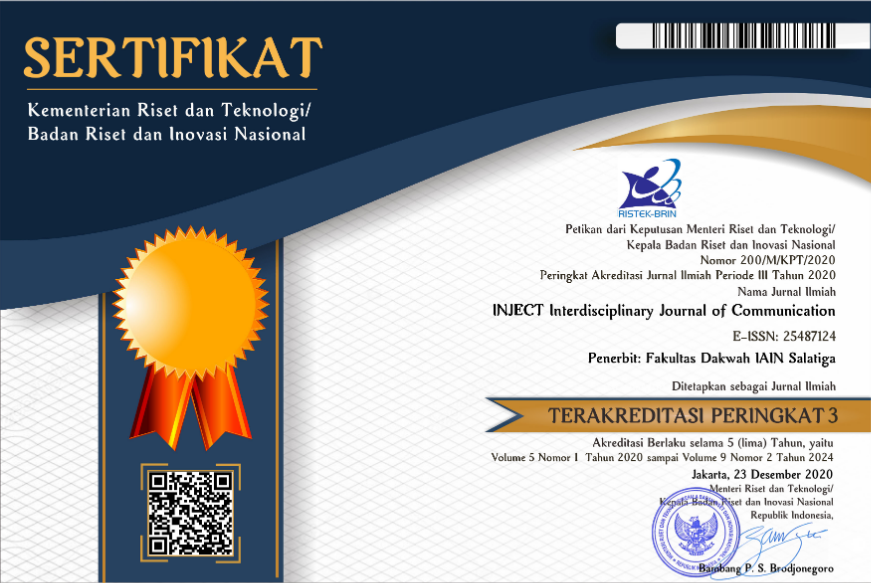Cultural Identity Background Toward The First Year Intercultural Communication Life Of Indonesian Phd Muslim Women Students In The USA
Abstract
This study aimed at investigating first year experience of international communication life of Indonesian PhD Muslim female students in the USA deal with their cultural background. Therefore, their cultural background influenced the host community in receiving their existence in the new environment both as international students and part of the the society. This study tried to explore how far Crenshaw intersectionality theory and Ting-Toomey’s theory on intercultural communication has assisted to formulate and answer the following: (1) How far is the influence of the cultural identity background has helped the students living in a country? and (2) To what extent does intercultural communication diminish the cultural background to formulate the success of these students?
This study is a qualitative approach using auto ethnography of depth interviews to picture the problems faced by the students. The study revealed that the ability to well-managed the cultural background in the circle of intercultural communication might help the success of the students both in the academic and social life.
Keywords
Full Text:
PDFReferences
Arifin, Win Listyaningrum. (2021). Intercultural Communication Life of Transnationals Indonesian PhD Muslim Women Studnts in the US and Australia.Haula: Indonesian Journal of Multiciplinary Islamic Studies. 5 (1). January 2021.
Arifin, Win Listyaningrum et.al. (2021). Tantangan tahun Pertama Pada Kehidupan Komunikasi Interkultural Mahasiswa Muslimah PhD Indonesia di Amerika Serikat dan Australia in Kontestasi Nalar keberagaman Kontemporer: Dari Konstruksi Identitas Menuju Koeksistensi Sosial. Yogyakarta: LkiS.
Arifin, Win Listyaningrum. (2020). Understanding Intercultural Communication Challenge of Indonesian PhD Muslim Female Students in the US and Australia as Trnasnationals. A Proceeding. 1st International Conference on Religion, Spiritualityy and Humanity (ICORESH): Religious Moderatism and The Future of Humanity. IAIN Salatiga, 10 November 2020.
Hashemnezhad, H., Yazdanfar, A., Heidari, A., Behdadfar, N. (2013). Comparison the concepts of sense of place and attachment to place in Architectural Studies. Malaysia Journal of Society and Space. 9 (1)
Hendrickson, B., Rosen, D., &Aune, R. K. (2011). An analysis of friendship networks, social connectedness, homesickness, and satisfaction levels of international students. International Journal of Intercultural Relations, 35(3), 281–295.
Hotta, J & Ting-Toomey, S. (2013). Intercultural adjustment and friendship dialectics in international students: A Qualitative study. International Journal of Intercultural Relations, 37 (5), 550-566.
Jorgensen, B. and Stedman, R. (2001). Sense of Place as an Attitude : Lakeshore Owners Attitudes Toward Their Properties. Journal of Environmental Psychology. 21, 233-248. doi:10.1006/jevp.2001.0226.
Klomegah, R. Y. (2006). Social factors relating to alienation experienced by international students in the United States. College Student Journal, 40(2), 303.
Li, R.Y. & Kaye, K. (1998). Understanding overseas students concerns and problems. Rose Yanhong Li and Kike Kaye. Journal of Higher Education Policy and Management. 20: 1, 41-50.
Li, Shuang & Zizzi, S. (2018). A case of international students’ social adjustment, friendship development, and physical activity. Journal of International Studies, Vol 8, Issue 1, 2018, 389-401.
Mukminin, Amirul. (2012). From East to West: A Phenomenological Study of Indonesian Graduate Students. Electronic Dissertation. The Graduate School: Florida State University Libraries.
Sawir, E., Marginson, S., Deumert, A., Nyland, C., & Ramia, G. (2008). Loneliness and international students: An Australian study. Journal of Studies in International Education, 12 (2), 148–180.
Snell, K. & and Zhou, C. (2015). Predicting acculturative orientations of American College Students toward international students. Journal of Intercultural Communication Research, 44: 3, 179-200.
Thurber, C.A. & Malton, E.A. (2012). Homesickness and adjustment in university students. Jornal of American College Health. 60: 5, 415-419.
Ting-Toomey, Stella. (1999). Communicating Across Cultures. New York, London: The Guilford Press.
Ting-Toomey, S. (2007). Intercultural conflict training: Theory-Practice approaches and research challenges. Journal of Intercultural Communication Research, 36(3), pp. 255-271
Warsono. 2010. “Prinsip-Prinsip dan Praktik keuangan Pribadi”. Journal of Science, volume 13 Nomor 2 Juli-Desember 2010
Wadsworth, Brooke C. et al. (2008). The Role of Identity Gaps, Discrimination, and Acculturation in International Students’ Educational Satisfaction in American Classrooms, Communication Education, 57:1, 64-87, DOI: 10.1080/03634520701668407
Weiss, M. L. & Ford, M. (2011). Temporary transnationals: South East Asian students in Australia. Journal of Contemporary Asia. 41: 2. 229-248.
Widjanarko, Putu. (2007). Homeland, Identit, and Media: A Study Of Indonesian Transnational Muslims in New ork City. A dissertaion at Ohio University.
Woodward, K. (Ed.). Questioning Identity: Gender, Class, Ethnicity. Ondon and New York: Routledge.
Zhou, Youfang et al. (2008). Theoretical models of culture shock and adaptation in international students in higher education. Studies in Higher Education. 33: 1, 63-75.
DOI: https://doi.org/10.18326/inject.v7i1.33-48
Refbacks
- There are currently no refbacks.
Copyright (c) 2022 Win Listyaningrum Arifin

This work is licensed under a Creative Commons Attribution 4.0 International License.








